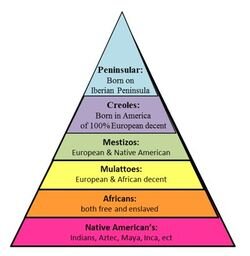Centerpiece
Inconceivable Member
- Messages
- 3,037
I knew you would be the one to shed more light on the subject... my wife is also knowledgeable on the issue too. She said perhaps it's more of a caste system issue - or "Classism" more-so than Racism. Or maybe it's a combination of both classism and racism. And it does vary from country to country according to her. (She lived in Panama, Honduras and Mexico and has traveled to almost all countries in Central and South America as well as Mexico and "the islands".)The social/racial hierarchy established by Spanish colonization still has legs today but it is a big region and in my experience the race part is especially varied from country to country and even within nations. All kinds of historical factors come into play in that figuring...were the indigenous people in a particular place wiped out or kept alive to work? What were the initial contact years like? Has the country seen lengthy progressive periods when civil rights were advanced or has it been a hard elitist clamp down from the get-go? And so on and so on...
This chart does a cursory job in helping one to imagine the colonial beginnings and their legacy...but again, it hardly demonstrates the profound complexity of even the early colonial racial classifications that remain extant in many ways today.
The fact that during the late colonial period it was possible to actually purchase "certificates of whiteness," [Limpieza de sangre] infused many places with a deeper class-based (i.e., wealth) element to the hierarchy. I think this is one of the more confusing factors looking in from the outside and in particular when viewing the divisions between Latin Americans and their descendants who have moved to the USA.
Like I wrote above...the waters are super complicated.
And then you throw in religion and you've got flat-out mud.
All I know is my wife's friend from Cuba (looks like he came straight from Madrid, and looks nothing like Cuban baseball player Aroldis Chapman, for example) told her, with a condescending sneer on his face: "Nancy, you speak Spanish just like a Mexican!" The racist/classism undertone in his voice was not lost on anyone.
The chart you shared is consistent with what I've thought all along in terms of hierarchy, and who looks down on whom.
It seems as if; you look like someone from Argentina (Messi) you're considered to be at the top of that chart. If you look like you are a native, indigenous Guatemalan you're at the bottom. If you look like Roberto Clemente, you're somewhere in between.

